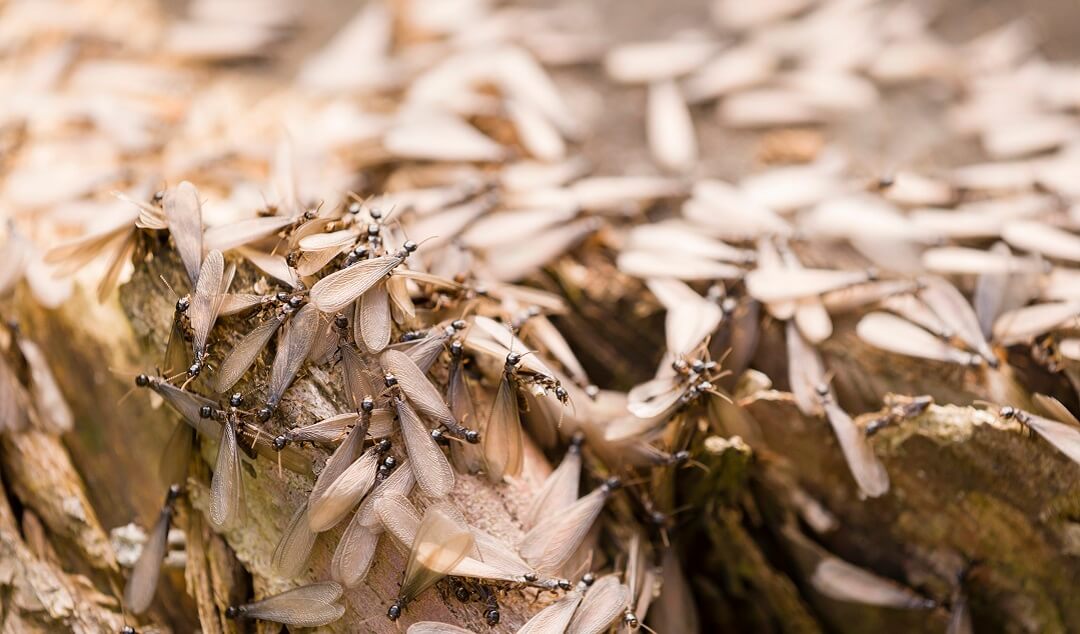Your home is a place to relax and enjoy time with family and friends. For termites, however, your home is often seen as an open buffet. While small pests, termites can cause extensive damage to your home in a very short time, so identifying a termite infestation early is essential. Even if you don’t have termites yet, having a yearly termite inspection is a great way to protect your home and catch termites before they can do damage. But what happens during a termite inspection? Here we explain what termite inspectors look for and how you can prepare for a termite inspection.
Key takeaways
- Termite inspection is a process to detect signs of termite infestation in your home, which can cause extensive damage.
- Trained professionals conduct a thorough inspection of the interior and exterior of your home, looking for evidence of termites.
- Key signs of termite activity include mud tubes, termite excrement, wood damage, evidence of swarmers, buckling paint, and changes in wall appearance.
- Termite inspectors also inspect all wood structures, yard areas, and fallen trees where termites may be present.
- Termite inspections are often free of charge, and yearly inspections can help prevent termite infestations and protect your home
What is a termite inspection?
A termite inspection is a process where trained experts inspect your home for any signs of termites. Unfortunately, termites are good at hiding their presence, often until it is too late. While you can monitor for visible evidence yourself, a trained professional is necessary to look for termite signs that are not always visible.
The process
The termite inspection process can take 1-2 hours and involves a detailed and thorough inspection of your home and property. The interior inspection looks at everything from baseboards and walls to crawl spaces, attics, and garages. Special attention is given to bathrooms, kitchens, and laundry rooms as plumbing is often an avenue of entry for subterranean termites.
After an interior examination, the inspector moves outside to look for signs of entry and infestation. This includes thoroughly examining the foundation, walls, eaves, and areas throughout your landscape that may show evidence of wood destruction, such as firewood piles.

What do termite inspectors look for?
Termite inspectors are looking for key pieces of evidence that may show termites have already established residence in your home. Here we take a closer look at some of the key elements of termite evidence an inspector may find.
Mud tubes
Mud tubes are the tunnels that connect termite nests to the buffet of wood inside your home that they feed on. These tubes are made of wood and soil and are roughly the width of a pencil. These tubes are clear evidence of subterranean termites, as dry wood termites do not utilize this method.
Termite excrement
Known as frass, termite excrement is another sign that you have active termite activity in your home. This frass appears as small, granular, oval-shaped pellets that are often found along baseboards, door frames, and windowsills.
Wood damage
Termites feed on the cellulose found in wood products and, if left untreated, can cause thousands of dollars in structural damage. When you have a termite inspection, the technician is looking for any potential wood damage that has already occurred. If wood within your home sounds hollow when knocked, it is often a sign of termite activity and potential damage.
Evidence of swarmers
Swarmers are the reproductive members of a termite colony. These termites have wings and will swarm when it is time for them to leave the nest and establish new colonies. Termite inspectors will look for signs of insect swarms outside your home. This can include live flying insects, but can also include the presence of termite wings in windowsills or other areas as these termites shed their wings when they find a mate.
Buckling paint
As termites feed on wood and drywall, they can create areas where moisture and air can enter underneath the paint on your walls. This moisture can create bubbles or a buckling effect underneath the paint. This is often a sign of termite activity.
Changes in wall appearance
In addition to hollow-sounding walls and buckling paint, termites can cause other visible changes to your walls. This can include pinholes in the walls where termites have eaten through, signs of intricate mazes showing through the wood, and damage to wood trim, such as baseboards.
Live termites
While live termites are often difficult to spot, inspectors are looking for signs of actual insects present during your inspection.

What areas do termite inspectors inspect?
During your termite inspection, technicians will inspect all areas where termites may be present. This will include all wood structures, including your home, deck, shed, carports, and fences. They will want to get into every area they can, such as crawl spaces and attics. In addition, they will inspect all areas in your yard where termites may be feeding, such as fallen trees, mulch, and firewood.
How much does a termite inspection cost?
The cost of termite inspections can vary based on area and the reason for the inspection. However, in many cases, termite inspections are often free of charge, as the extermination company makes its money on the treatment and structural damage repair.
Preparing for a termite inspection
Once you schedule your termite inspection, you will need to do a few things to prepare. This includes clearing out areas underneath sinks and making sure there is a clear pathway and accessibility to your attic, crawlspace, and garage.
Addressing possible termite infestations
If you believe you already have a termite infestation, an immediate inspection is necessary to identify the termites and begin treatment in order to reduce the risk of serious structural damage. However, the best course of action when it comes to termites is prevention. Scheduling yearly termite inspections can help ensure you catch a potential infestation before damage is done.
Keeping your home termite-free
At Insight Pest Management, our technicians are experts in termite identification and treatment. We understand the severe damage that these pests can cause and work with you to ensure your home is termite-free and remains that way. To learn how we can help, schedule a free evaluation today.


